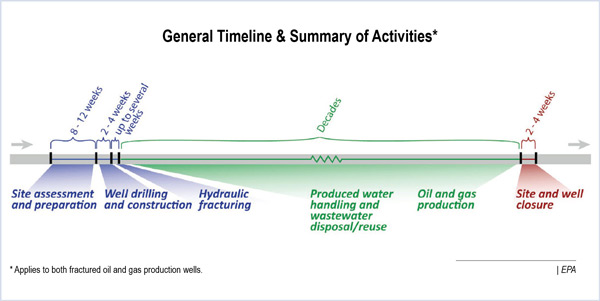By Rich Heidorn Jr.
In a widely anticipated report, EPA said yesterday that fracking has harmed drinking water resources under some circumstances but that data gaps have made it impossible to quantify the scope of the problem.
The agency said it identified cases of impacts on drinking water at each stage in the fracking water cycle: acquiring water for use in fracking; mixing the water with chemical additives; injecting the water and chemicals into the production well to create and increase fractures; collecting wastewater after injection; and disposing or reusing wastewater.

“Impacts cited in the report generally occurred near hydraulically fractured oil and gas production wells and ranged in severity, from temporary changes in water quality to contamination that made private drinking water wells unusable,” EPA said.
The report identifies conditions under which impacts can be more frequent or severe, including:
- Water withdrawals in times or areas of low water availability, particularly areas with limited or declining groundwater;
- Spills of fracking fluids or wastewater involving large volumes or high concentrations of chemicals reaching groundwater;
- Injections into wells whose steel casing or cement lacked “mechanical integrity,” allowing gases or liquids to escape;
- Injections directly into groundwater resources;
- Discharge of inadequately treated wastewater to surface water resources; and
- Disposal or storage of wastewater in unlined pits.
“This assessment is the most complete compilation to date of national scientific data on the relationship of drinking water resources and hydraulic fracturing,” Dr. Thomas A. Burke, deputy assistant administrator of EPA’s Office of Research and Development, said in a statement.

EPA said, however, the report “was not designed to be a list of documented impacts.”
“Data gaps and uncertainties limited EPA’s ability to fully assess the potential impacts on drinking water resources both locally and nationally. Generally, comprehensive information on the location of activities in the hydraulic fracturing water cycle is lacking, either because it is not collected, not publicly available, or prohibitively difficult to aggregate,” the agency said. “In places where we know activities in the hydraulic fracturing water cycle have occurred, data that could be used to characterize hydraulic fracturing-related chemicals in the environment before, during and after hydraulic fracturing were scarce. Because of these data gaps and uncertainties, as well as others described in the assessment, it was not possible to fully characterize the severity of impacts, nor was it possible to calculate or estimate the national frequency of impacts on drinking water resources from activities in the hydraulic fracturing water cycle.”
Done at the request of Congress, the report was based on a review of more than 1,200 cited scientific sources, new research conducted as part of the study and an independent peer review by EPA’s Science Advisory Board. The board had been sharply critical of a 2015 draft that said the agency “did not find evidence that [fracking activities] have led to widespread, systemic impacts on drinking water resources” in the U.S.



